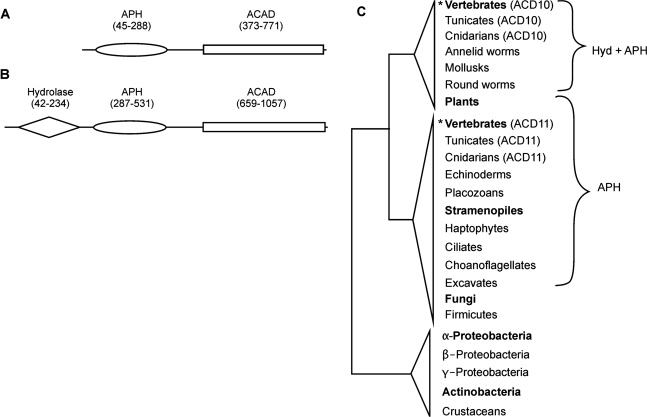Figure 3.
Distinction of ACD10 and ACD11. Protein domains of human ACD11 and ACD10 (Q709F0, A) and ACD10 (Q6JQN1, B). InterProt domain IDs are as follows: hydrolase domain, IPR005834; APH domain, IPR002575. The ACAD domain is composed of three parts: ACAD N-terminal domain, IPR013786; ACAD central domain, IPR006091; ACAD C-terminal domain, IPR013764. (C) Domain content of ACD10, ACD11 and provisional ACD10/11 homologs mapped onto the phylogenetic tree. Taxa representing more than three species are shown in bold. Clades with bootstrap support value >90 are labeled with asterisk. Taxa that appear twice in the tree are distinguished by the labels ‘ACD10’ and ‘ACD11’. In animals, ACD11 includes (in addition to the common ACAD domains) an APH domain, and ACD10 possesses an APH plus a hydrolase (Hyd) domain. Exceptions are gi|115941654 of the echinoderm Strongylocentrotus purpuratus, which is more similar to ACD10 but lack the hydrolase domain, and jgi|Dappu1|346313 of the crustacean Daphnia pulex, which shares equal sequence similarity with ACD10 and ACD11 and lacks both extra domains. Homologs of other eukaryotes, which have an APH domain, but no hydrolase domain, are classified as ACD11. Sequences lacking both domains are all homologs of fungi, the green algae Volvox carteri and Ostreococcus lucimarinus and the stramenopiles Aureococcus anophagefferens and Phytophthora ramorum. Bacterial homologs also lack both domains. Those lacking both domains are classified as ACD11n, see text.

